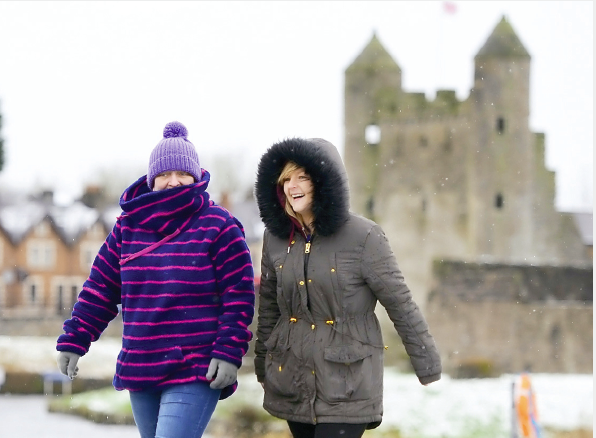
KEEPING WARM… Phyllis McGrath and Siobhan McGirr take a brisk stroll on their
lunch break from BT Enniskillen during a chilly spell in Enniskillen last year RMG09
THOSE dreaming of a white Christmas here in Fermanagh may be in for yet another year of disappointment, despite many long range forecasts predicting a cold winter ahead.
There may be semi-apocalyptic warnings from some quarters that we’re facing one of the coldest winters for years, however both the Met Office and Met Eireann have dashed the hopes of many a romantic here in the county, stating the chances of picture-postcard scene of snow-capped spires in Enniskillen is highly unlikely.
Indeed, you are statistically more likely to see a dusting of the white stuff on your morning commute during the depressing days of January and February.
LIKELY TO SNOW?
“Christmas is only at the beginning of the period when it’s likely to snow,” explained the Met Office. “We are more likely to see snow between January and March than in December with snow or sleet falling an average 3.9 days in December, compared to 5.3 days in January, 5.6 days in February and 4.2 days in March.
“White Christmases were more frequent in the 18th and 19th centuries, even more so before the change of calendar in 1752 which effectively brought Christmas day back by 12 days.
Climate change has also brought higher average temperatures over land and sea and this generally reduced the chances of a white Christmas.”
Met Eireann also stated the same regarding Irish weather patterns, and explained the romantic notion of snow at Christmas, despite not being common at this time of year, probably came from an era from which many of our current festive traditions originated, and when winter weather patterns were different from those today.
“In modern times, snow is synonymous with Christmas. Christmas cards, songs and scene from the Victorian period, notably in Charles Dickens’ novels, all portray snow falling at Christmas,” said Met Eireann’s Aidan Murphy. “The origins of a white Christmas may originally have come from the ‘Little Ice Age’ that occurred during the period 1550-1850.”
Mr Murphy said Ireland had only seen countrywide snow on Christmas Day 17 times since 1961, most recently in 2010 which was one of the coldest days ever recorded.
He also added that while for many people a white Christmas means snow covering the ground, those having a flutter on it this year may be in for a little more luck with most bookmakers requiring only a single snow flake to fall during the 24 hours of December 25 at Dublin Airport.
This happens, on average, every six years or so. All hope is not entirely lost for those hoping for a proper snow fall, however, with both Met Eireann and the Met Office stressing it is only really possible to forecast any form of weather accurately no longer than five days in advance.










